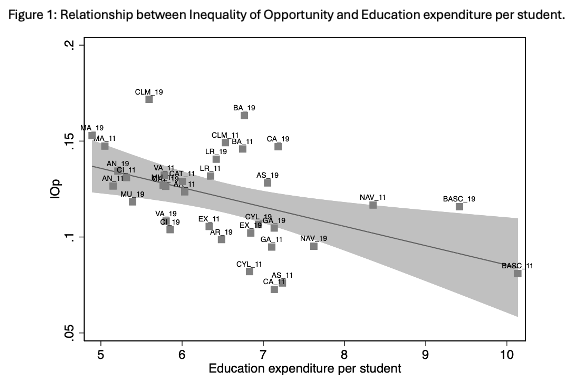This blog is based on an article in Social Policy and Society by Ana Suárez Àlvarez and Ana Jesús López Menėndez. Click here to access the article.
Family background characteristics and educational resources are crucial in shaping individuals’ income. The unequal distribution of these resources is thus a potential source of inequality of income and opportunity. In this sense, analysing the relevance of family background to individuals’ income is important in understanding how income is determined by factors beyond ‘personal responsibility’ and, consequently, the extent to which a society is able to guarantee equal opportunities for all.
Ensuring equal opportunities would mean all individuals are able to achieve a certain level of income regardless of the level of income, wealth or education attained by their parents or any other circumstances beyond their own control. Moreover, educational inequalities and income inequalities are closely related and empirical research has found that educational inequality contributes to the widening of income gaps.
In this context, our research aims to understand how different educational and family backgrounds are related to observed levels of inequality. The analysis is focused on the Spanish Regions. We believe it is an interesting case of study due to several reasons: (1) there are significant income inequalities between regions; (2) the distribution of income growth amongst the population differs between regions; and (3) education systems are different since the responsibilities for education are shared by the Spanish regions and the central government, resulting in differences in systems across regions.
Our research answers two research questions (1) To what extent are family background characteristics important in shaping inequalities? and (2) What are the main drivers of inequalities across regions?
For this, we use data from the European Survey of Income and Living Conditions (EU-SILC) and Spanish regions are analysed at NUTS-II levels, which correspond to the 17 Spanish Autonomous Communities (CCAA): the first level political and administrative division. Moreover, in addition to estimating income inequality, we compute Inequality of Opportunity (IOp) for the Spanish regions and then analyse the contribution of variables such as parental occupation and education to IOp.
To what extent are family background characteristics important in shaping inequalities?
To answer this question, we estimate IOp and then the contribution of parental education, parental occupation and financial difficulties during childhood using the shapely value procedure, which allows us to compute the marginal effects of these variables to IOp.
Findings show these circumstances are of great relevance in shaping inequalities. The exceptions are four northeastern regions (Navarre, La Rioja, Aragon and Catalonia) where the relative importance of family background characteristics is lower. Since the importance of family background characteristics varies greatly, it is relevant to analyse the determinants of these regional differences.
What are the main drivers of inequalities across regions?
We then analysed the correlations between inequality variables and their potential determinants, such as economic, demographic, and educational variables.
Educational variables have the highest levels of correlation with inequality variables. More specifically, the two educational variables that show the highest levels of correlation with inequality are the average student/teacher ratio and education expenditure per student. The student/teacher ratio correlation implies that the higher the average number of students per teacher, the higher the levels of inequality and IOp. Additionally, the correlation between expenditure per student and inequality shows the greater the expenditure the lower the inequality, as illustrated in Figure 1. These results show there is a significant association between the levels of inequality and educational resources, both economic (educational expenditure) and human capital (students/teacher ratio). It is observed that those regions with a greater endowment of educational resources exhibit lower levels of inequality.

We also perform several regressions to see if the previously observed associations entail causal relationships. The regression analysis shows that an increase in unemployment rate would cause an increase in income inequality. Additionally, expenditure on education is significant in explaining IOp, showing that an increase in spending would reduce it.
Concluding remarks and policy implications
Our analysis reveals that family background has a great impact on individual income and is a crucial source of unequal opportunities. For the Spanish regions, family background characteristics, specifically parental education, occupation, and financial situation during childhood are of great importance in shaping individual opportunities.
We analyse the main drivers of regional differences in income inequality and IOp, finding that educational variables are highly associated with inequality. The regression analyses show there is a causal relation between educational resource endowments and observed inequalities: regions that invest more in education experience lower levels of inequality.
Results suggest that different regional educational policies, reflected in differences in expenditure, are important determinants of regional inequalities, especially of inequality of opportunity.
The results also indicate that an increase in social expenditures could have an equalising effect on income, which underlines the importance of targeted policies that can effectively address existing inequalities and specifically target the groups that need them.
About the authors
Ana Suárez Àlvarez is a Researcher at the University of Oviedo, Spain.
Ana Jesús López Menėndez is Professor at the University of Oviedo, Spain.
